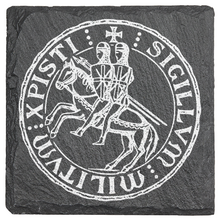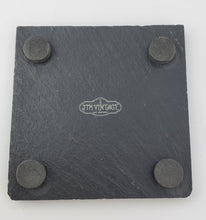Seal of the Knights Templar engraved on fine Slate Coaster, More than a coaster. It's art, It's History.
Own a piece of history that will last as long as the legends.
"Get Inspired"  ®
®
Specifications:
The coaster measures 4X4 inches
-
-
History.
The inscription surrounding the Seal varied according to the Grand Master. The sixth Grand Master, Bertrand de Blanquefort – to whom is credited the design of the first Seal in 1168 – used the inscription SIGILLUM MILITUM on the obverse and CRISTI DE TEMPLO on the reverse.
A hundred years later, the nineteenth Grand Master, Renaud de Vichiers, was using the same image, but with the inscription reading SIGILLUM MILITUM XPISTI.
It is interesting to note the admixture of Latin and Greek letters in that motto. The use of the Greek XP (“Chi Ro”), instead of the Latin CHR (as in Christ) is a reminder of Christianity’s roots from the time of Emperor Constantine in the 4th Century after he adopted it following the vision that led to his conversion.
The “two knights on a horse” image is popularly explained by suggesting that sharing what would have been a vital commodity in those days confirmed their adherence to the vows of poverty that all had to take to join the Order.
There is some evidence that the image was primarily used by French Templar Knights, as it is not found in English Templar documents of the period.
This explanation is somewhat contradicted by the Latin Rules of the Templars, written in 1128 and attributed to Bernard de Clairvaux.
Specifically Rule 51 states “each Knight Brother may have three horses and no more without the permission of the Master, because of the great poverty which exists at the present time in the House of God and of the Temple of Solomon. To each Knight Brother, we grant three horses and one squire, and if that squire willingly serves charity, the Brother should not beat him for any sin he commits”.
Whatever the explanation, the image of two knights sharing a horse is so powerful that it has endured over the centuries and is used to this day by the Great Priory of the Order of the Temple in England and Wales. The subscription, “Pauperes Commilitones Christi” translates as the “Poor Fellow-Soldiers of Christ”.
-



